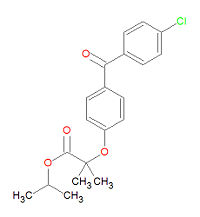Fenofibrate
Fenofibrate, also known as fenofibrato(Spanish), fenofibratum (Latin), FNF and finofibrate, is an antilipemic agent which reduces both cholesterol and triglycerides in the blood. Its IUPAC name is propan-2-yl 2-[4-(4-chlorobenzoyl)phenoxy]-2-methylpropanoate and its chemical formula is C20H21ClO4. Fenofibric acid is the active metabolite of fenofibrate, that produces reductions in total cholesterol, LDL cholesterol, apolipoprotein B, total triglycerides and triglyceride rich lipoprotein (VLDL) in treated patients. In addition, treatment with fenofibrate results in increases in high density lipoprotein (HDL) and apoproteins apoAI and apoAII.
Fenofibrate also lowers uric acid in the blood.[1]
Fenofibrate activates peroxisome proliferator activated receptor a (PPARa), which increases lipolysis and elimination of triglyceride-rich particles from plasma by activating lipoprotein lipase and reducing production of apoprotein C-III. The resulting decrease in triglycerides alters the size and composition of LDL from small, dense particles, to large buoyant particles. These larger particles have a greater affinity for cholesterol receptors and are catabolized rapidly.
Brand Names
- Ankebin
- Antara
- Elasterate
- Elasterin
- Fenobrate
- Fenogal
- Fenotard
- Lipanthyl
- Lipantil
- Lipidex
- Lipidil
- Lipidil Micro
- Lipidil Supra
- Lipifen
- Lipirex
- Lipoclar
- Lipofene
- Liposit
- Lipsin
- Lofibra
- Luxacor
- Nolipax
- Procetofen
- Proctofene
- Protolipan
- Secalip
- Sedufen
- Tricor
- Triglide
External Links
The most up-to-date information about Fenofibrate and other drugs can be found at the following sites.
- Fenofibrate - FDA approved drug information (drug label) from DailyMed (U.S. National Library of Medicine).
- Fenofibrate - Drug information for consumers from MedlinePlus (U.S. National Library of Medicine).
- Fenofibrate - Detailed information from DrugBank.
- ↑ Feher MD, Hepburn AL, Hogarth MB, Ball SG, Kaye SA (February 2003). "Fenofibrate enhances urate reduction in men treated with allopurinol for hyperuricaemia and gout". Rheumatology (Oxford) 42 (2): 321–5. PMID 12595630. [e]
